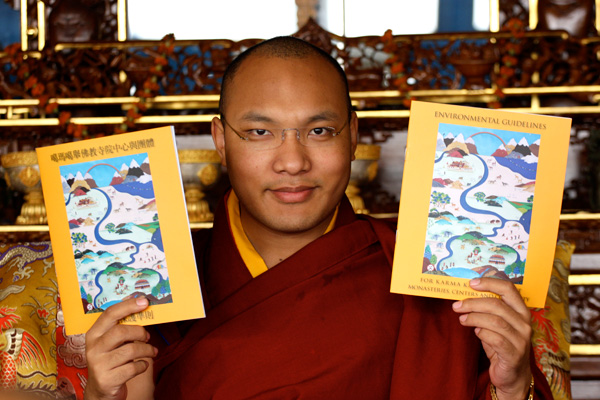法王新闻 | 2009年01月
鄭重介紹「噶瑪噶舉佛教寺院中心與團體的環境保護準則」手冊
Gyalwang Karmapa Launches His Booklet: Environmental Guidelines for Karma Kagyu Buddhist Monasteries, Centers and Community

地點:印度 菩提迦耶
時間:2009年01月20日 January 21, 2009 by Naomi Levine
報導:Jo Gibson
攝影:噶瑪善治
由法王指導完成的「噶瑪噶舉佛教寺院中心與團體的環境保護準則」手冊,在祈願法會中的後半段時開放請購。目前這個手冊備有中 、英文兩種版本,而藏文版將會在今年的二/三月份問世。法王在對西方弟子課程的第二天上課當中,簡要地說明了這本手冊的內容 ,以及法王本身對環境保育的至深關切。
Gyalwang Karmapa’s booklet, Environmental Guidelines for Karma Kagyu Buddhist Monasteries, Centres and Community went on sale at the end of Kagyu Monlam. So far the booklet has been published in English and Chinese; the Tibetan edition should be available in February/March 2009. His Holiness briefly described the booklet and his own deep concerns about the environment on the second day of the Western teaching.
法王在第二十五屆的祈願法會中首度提出他對環境問題的關切。而在今年第二十六屆的祈願法會中,法王再度提出了他的憂慮。法王列舉了這本手冊中所對治的五項重點 :印度與西藏森林的濫伐,水資源的危機,野生動物的保護,廢棄物的處理,以及全球氣候的暖化與變遷。
He explained how he had first spoken about environmental concerns at the end of the 25th Kagyu Monlam. He had mentioned his worries again in his concluding speech at the 26th Kagyu Monlam. He then detailed the five sections of the booklet, by highlighting the destruction of forests in India and Tibet, the danger to water supplies, the protection of wildlife, the need for waste management, and the threat of global warming and climate change.
法王毫不諱言地指出有些寺院將林木砍伐出售的行為是不當的行為,這種行為應當停止,而受到破壞的林木也必須被重新栽植。喜馬拉雅山域的冰河與融雪是由西藏流向中國 、緬甸、印度、與巴基斯坦等河川的來源,更是亞洲地區百萬居民生命的泉源。因此,保護這個地區的水源並防範水源的污染極其地重要。
He admitted the culpability of some monasteries in cutting down trees to be sold as timber. This had to be stopped and those forests replanted. Glaciers and snow melt in the Himalayan region are the source of water and thereby the source of life for millions of people throughout Asia, rivers from Tibet flow to China, Burma, India and Pakistan, so it was essential to both protect the source and prevent the rivers becoming polluted.
在野生動物的保育這方面已有了些許的進展。在幾年前的西藏,以老虎與豹等動物皮毛做為裝飾仍然是項習俗。自從第十四世達賴喇嘛對於這項行為的譴責後 ,大部份的人已停止這樣的行為,而令這些亞洲瀕臨絕種的動物得以保存。對於那些仍然食肉的人,法王強調應當認真地考慮減少肉食 ,因為肉品製造所耗費的額外資源對環境有著直接的影響。
There had been some advances in the area of wildlife protection. A few years ago in Tibet it was the custom to use tiger and leopard skins and other animal skins for decoration, but since His Holiness the 14th Dalai Lama condemned this practice, it had mostly stopped, and this had helped prevent the extinction of these animals in Asia. For those people who still ate meat, Gyalwang Karmapa emphasized the need to think seriously about reducing the amount of meat they eat because the additional resources needed to produce meat had a direct effect on the environment.
在廢棄物處理方面,法王也解釋道,寺院在過去並沒有這方面的習慣與訓練,若是能給予寺院一些特殊的訓練,那麼他們就能夠成為一個領頭的榜樣。法王希望這樣的知識與實踐最終能夠擴及到整個社會當中。
>He explained that monasteries did not have a training or culture in waste management so by giving them special training so that they could lead by example, he hoped that knowledge and practice would spread into society at large.
至於氣候變遷的危機,特別是喜馬拉雅山域的變化是其他地區的五倍的情況之下,氣候變遷是會影響到世界上的每一個人。但無論如何 ,每一個人都必須負擔起環境保育的責任,而我們所付出的努力也代表了我們是不是真正地致力於所有眾生的福祉。
As to the crisis of climate change – especially in the Himalayan regions where it is happening up to five times more quickly – it was a change which would affect everybody in the world.
法王的下一個實施計劃為在三月份與各寺院住持以及仁波切的環保會議。每一個寺院都必須選出一位環保協調員以便接受更多的訓練。
The next stage of implementation of his proposals will be a conference in mid-March for abbots and Rinpoches. Each monastery will be asked to appoint an environmental protection co-ordinator, and these people will receive additional training.
《噶瑪噶舉佛教寺院中心與團體的環境保護準則》電子書下載
A PDF of His Holiness’ Environmental Guidelines Booklet can be downloaded here.
The Environment
For several years His Holiness Karmapa has been concerned to implement changes in Buddhist monasteries all over the world to address the environmental crisis. This year he brought out a booklet to be distributed to all the monasteries. (There are 350 million Buddhists on the planet, according to the pamphlet.) It is entitled Environmental Guidelines and breaks down the problem into 5 categories: forest protection, water protection, wildlife protection, waste management and addressing climate change.
We watched some significant changes taking place right here in Bodh Gaya.
Environmental architectural designer Lillian Sum has been raising awareness on environmental issues for the last 7 years.
‘I’ve dedicated my life to working on the environment. We are really pleased and relieved His Holiness Karmapa is raising awareness among the Tibetan sangha. From there it will be a light beacon to raise awareness all over the world.
His Holiness asked me to clear the rubbish on Tergar Monastery road. At first I thought it was a joke. Then he said he would request 500 Tergar monks to help me. A year’s worth of Bodh Gaya rubbish was dumped on a 60 metre stretch of road ten feet across, and five foot deep. It took over 80 tractor loads to move it. We moved the land; what I thought was land was actually rubbish!
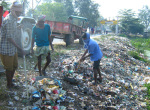
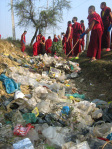
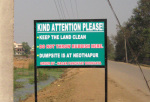
We worked in co-operation with the Nagar Panchaiyat (the local council) and the Bodhgaya Temple Management committee, who agreed to help and give support as did the hotels. We’re working on setting up a sustainable waste disposal system. And during the process of this clean up we set up an official landfill site for all of Bodhgayas waste. Local business people and social workers have been most helpful and amazing in their support. The local people are really keen to clean up the rest of Bodh Gaya and are setting up an environmental organisation.’


HH Karmapa and LillianHH Karmapa planting a Tree in TergarHis Holiness also asked Lillian to plant some trees at the side of the monastery- guavas, mangoes and other fruit trees. Karmapa came down from his roof top apartment and placed a tree into the ground. It was a great photo opportunity.

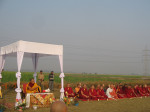
HH Karmapa Land BlessingHH Karmapa land blessingOn January 16 at 8am His Holiness walked in procession with his entourage to a field adjoining Tergar and sat under a white canopy using a red megaphone to say prayers to bless the land. The site will house a new building for the Kagyu Monlam. It was delightful to drink tea, eat apple pie and enjoy the green peace of the fields in the early morning sun.
